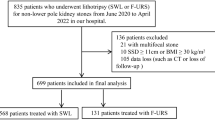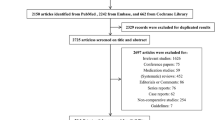Abstract
The objective of the study was to systematically review the efficacy and safety of flexible ureterorenoscopy (F-URS) with holmium laser versus extracorporeal shock wave lithotripsy (ESWL) for the treatment of renal stone <2 cm. A systematic literature review was performed in April 2015 using the PubMed, Embase, Web of Science and the Chinese Biomedical Literature (CNKI and Wanfang) databases to identify relevant studies. All clinical trials were retrieved and their included references investigated. Two reviewers independently assessed the quality of all included studies, and the eligible studies were included and analyzed using the RevMan 5.3 software. Six prospective randomized comparison trials and eight retrospective comparison trials were included, involving a total of 2348 patients. For renal stone 1–2 cm, F-URS technique provided a significantly higher stone-free rate (SFR) [weighted mean difference (WMD) = 2.35, 95 % confidence interval (CI) 1.65–3.34, P < 0.00001], lower auxiliary procedure rate (APR) [odds ratio (OR) 0.33, 95 % CI 0.22–0.50, P < 0.00001] and lower retreatment rate (RR) (OR 0.07, 95 % CI 0.01–0.37, P = 0.002). Similar results were found in the lower pole stone for 1–2 cm subgroup. For renal stone <1 cm, F-URS technique also showed a significantly higher SFR than ESWL (WMD = 2.13, 95 % CI 1.13–4.00, P = 0.02). F-URS is associated with higher SFR, lower APR and RR than ESWL. F-URS is a safe and effective procedure. It can successfully treat patients with stones for 1–2 cm, especially for lower pole stone, without increasing complications, operative time and hospital stay. F-URS can be used as an alternative treatment to ESWL in selected cases with larger renal stones. However, further randomized trials are needed to confirm these findings.











Similar content being viewed by others
References
Litwin MS, Saigal C (2012) Urologic diseases in America. US Government Printing Office, Washington, DC
Taylor EN, Stampfer MJ, Curhan GC (2005) Obesity, weight gain, and the risk of kidney stones. JAMA 293:455–462
Abate N, Chandalia M, Cabo-Chan AV Jr, Moe OW, Sakhaee K (2004) The metabolic syndrome and uric acid nephrolithiasis: novel features of renal manifestation of insulin resistance. Kidney Int 65:386–392
Ghani KR, Sammon JD, Karakiewicz PI, Sun M, Bhojani N, Sukumar S et al (2013) Trends in surgery for upper urinary tract calculi in the USA using the Nationwide Inpatient Sample: 1999–2009. BJU Int 112:224–230
Lee MC, Bariol SV (2011) Evolution of stone management in Australia. BJU Int 108:S29–S33
Ordon M, Urbach D, Mamdani M, Saskin R, D’A Honey RJ RJ et al (2014) The surgical management of kidney stone disease: a population based time series analysis. J Urol 192:1450–1456
Na YQ, Ye ZQ, Sun YH, Sun G (2013) The guideline for diagnosis and treatment of urology disease 2014. People’s Medical Publishing House, Beijing
Türk C, Knoll T, Petrik A, Sarica K, Skolarikos A et al (2014) Guidelines on urolithiasis. European Association of Urology, The Netherlands
El-Nahas AR, Ibrahim HM, Youssef RF, Sheir KZ (2012) Flexible ureterorenoscopy versus extracorporeal shock wave lithotripsy for treatment of lower pole stones of 10–20 mm. BJU Int 110:898–902
Pearle MS, Lingeman JE, Leveillee R, Kuo R, Preminger GM et al (2008) Prospective randomized trial comparing shock wave lithotripsy and ureteroscopy for lower pole caliceal calculi 1 cm or less. J Urol 179:S69–S73
Aboutaleb H, El-Shazly M, Badr Eldin M (2012) Lower pole midsize (1–2 cm) calyceal stones: outcome analysis of 56 cases. Urol Int 89:348–354
Cecen K, Karadag MA, Demir A, Bagcioglu M, Kocaaslan R et al (2014) Flexible Ureterorenoscopy versus Extracorporeal Shock Wave Lithotripsy for the treatment of upper/middle calyx kidney stones of 10–20 mm: a retrospective analysis of 174 patients. Springerplus 3:557
Phillips B, Ball C, Sackett D, Oxford centre for evidence-based medicine-levels of evidence [updated 2009]. Centre for evidence-based medicine. http://www.cebm.net/index.aspx?o=1025
Clark HD, Wells GA, Huet C, McAlister FA, Salmi LR et al (1999) Assessing the quality of randomized trials: reliability of the Jadad scale. Control Clin Trials 20:448–452
Wells G, Shea B, O’Connell D. The Newcastle Ottawa scale (NOS) for assessing the quality of nonrandomized studies in meta analysis. Ottawa Hospital Research Institute. http://www.ohri.ca/programs/clinical_epidemiology/oxford.asp
Hozo SP, Djulbegovic B, Hozo I (2005) Estimating the mean and variance from the median, range, and the size of a sample. BMC Med Res Methodol 5:13
Mantel N, Haenszel W (1959) Statistical aspects of the analysis of data from retrospective studies of disease. J Natl Cancer Inst 22:719–748
DerSimonian R, Laird N (1986) Meta-analysis in clinical trials. Control Clin Trials 7:177–188
Higgins JP, Altman DG, Gøtzsche PC, Jüni P, Moher D et al (2011) The Cochrane Collaboration’s tool for assessing risk of bias in randomised trials. BMJ 343:d5928
Singh BP, Prakash J, Sankhwar SN, Dhakad U, Sankhwar PL et al (2014) Retrograde intrarenal surgery vs extracorporeal shock wave lithotripsy for intermediate size inferior pole calculi: a prospective assessment of objective and subjective outcomes. Urology 83:1016–1022
Kumar A, Kumar N, Vasudeva P, Kumar Jha S, Kumar R et al (2015) A prospective, randomized comparison of shock wave lithotripsy, retrograde intrarenal surgery and miniperc for treatment of 1 to 2 cm radiolucent lower calyceal renal calculi: a single center experience. J Urol 193:160–164
Mokhless IA, Abdeldaeim HM, Saad A, Zahran AR (2014) Retrograde intrarenal surgery monotherapy versus shock wave lithotripsy for stones 10 to 20 mm in preschool children: a prospective, randomized study. J Urol 191:1496–1499
Sener NC, Bas O, Sener E, Zengin K, Ozturk U et al (2015) Asymptomatic lower pole small renal stones: shock wave lithotripsy, flexible ureteroscopy, or observation? A prospective randomized trial. Urology 85:33–37
Sener NC, Imamoglu MA, Bas O, Ozturk U, Goktug HN et al (2014) Prospective randomized trial comparing shock wave lithotripsy and flexible ureterorenoscopy for lower pole stones smaller than 1 cm. Urolithiasis 42:127–131
Kumar A, Vasudeva P, Nanda B, Kumar N, Das MK et al (2015) A prospective randomized comparison between shock wave lithotripsy and flexible ureterorenoscopy for lower caliceal stones ≤2 cm: a single-center experience. J Endourol 29:575–579
Koo V, Young M, Thompson T, Duggan B (2011) Cost-effectiveness and efficiency of shockwave lithotripsy vs flexible ureteroscopic holmium: yttrium–aluminium–garnet laser lithotripsy in the treatment of lower pole renal calculi. BJU Int 108:1913–1916
Vilches RM, Aliaga A, Reyes D, Sepulveda F, Mercado A et al (2015) Comparison between retrograde intrarenal surgery and extracorporeal shock wave lithotripsy in the treatment of lower pole kidney stones up to 15 mm. Prospective, randomized study. Actas Urol Esp 39:236–242
Kiremit MC, Guven S, Sarica K, Ozturk A, Buldu I et al (2015) Contemporary management of medium-sized (10–20 mm) renal stones: a retrospective multicenter observational study. J Endourol 29:838–843
Ozturk U, Sener NC, Goktug HN, Nalbant I, Gucuk A et al (2013) Comparison of percutaneous nephrolithotomy, shock wave lithotripsy, and retrograde intrarenal surgery for lower pole renal calculi 10–20 mm. Urol Int 91:345–349
Xu YX, Duan JL, Zhou XJ (2014) Comparison of shock wave lithotripsy, flexible ureterorenoscopy and percutaneous nephrolithotripsy on renal pelvis stones between 1 and 2 cm. Int J Urol Nephrol 34:826–828
Bas O, Bakirtas H, Sener NC, Ozturk U, Tuygun C et al (2014) Comparison of shock wave lithotripsy, flexible ureterorenoscopy and percutaneous nephrolithotripsy on moderate size renal pelvis stones. Urolithiasis 42:115–120
Resorlu B, Unsal A, Ziypak T, Diri A, Atis G et al (2013) Comparison of retrograde intrarenal surgery, shockwave lithotripsy, and percutaneous nephrolithotomy for treatment of medium-sized radiolucent renal stones. World J Urol 31:1581–1586
Matlaga BR, Assimos DG (2002) Changing indications of open stone surgery. Urology 59:490–493
Raman JD, Pearle MS (2008) Management options for lower pole renal calculi. Curr Opin Urol 18:214–219
Wu CF, Shee JJ, Lin WY, Lin CL, Chen CS (2004) Comparison between extracorporeal shock wave lithotripsy and semirigid ureterorenoscope with holmium:YAG laser lithotripsy for treating large proximal ureteral stones. J Urol 172:1899–1902
Sampaio FJ, Aragao AH (1994) Limitations of extracorporeal shockwave lithotripsy for lower caliceal stones: anatomic insight. J Endourol 8:241–247
El-Nahas AR, El-Assmy AM, Mansour O, Sheir KZ (2007) A prospective multivariate analysis of factors predicting stone disintegration by extracorporeal shock wave lithotripsy: the value of high-resolution noncontrast computed tomography. Eur Urol 51:1688–1693
Abe T, Akakura K, Kawaguchi M, Ueda T, Ichikawa T et al (2005) Outcomes of shockwave lithotripsy for upper urinary-tract stones: a large-scale study at a single institution. J Endourol 19:768–773
Egilmez T, Tekin MI, Gonen M, Kilinc F, Goren R et al (2007) Efficacy and safety of a new-generation shockwave lithotripsy machine in the treatment of single renal or ureteral stones: experience with 2670 patients. J Endourol 21:23–27
Tan YM, Yip SK, Chong TW, Wong MY, Cheng C et al (2002) Clinical experience and results of ESWL treatment for 3,093 urinary calculi with the Storz Modulith SL 20 lithotripter at the Singapore general hospital. Scand J Urol Nephrol 36:363–367
Müller-Mattheis VG, Schmale D, Seewald M, Rosin H, Ackermann R (1991) Bacteremia during extracorporeal shock wave lithotripsy of renal calculi. J Urol 146:733–736
Skolarikos A, Alivizatos G, de la Rosette J (2006) Extracorporeal shock wave lithotripsy 25 years later: complications and their prevention. Eur Urol 50:981–990
Maker V, Layke J (2004) Gastrointestinal injury secondary to extracorporeal shock wave lithotripsy: a review of the literature since its inception. J Am Coll Surg 198:128–135
Bozkurt OF, Resorlu B, Yildiz Y, Can CE, Unsal A (2011) Retrograde intrarenal surgery versus percutaneous nephrolithotomy in the management of lower-pole renal stones with a diameter of 15 to 20 mm. J Endourol 25:1131–1135
Geavlete P, Georgescu D, Niţă G, Mirciulescu V, Cauni V (2006) Complications of 2735 retrograde semirigid ureteroscopy procedures: a single-center experience. J Endourol 20:179–185
Hussain M, Acher P, Penev B, Cynk M (2011) Redefining the limits of flexible ureterorenoscopy. J Endourol 25:45–49
Tefekli A, Ali Karadag M, Tepeler K, Sari E, Berberoglu Y et al (2008) Classification of percutaneous nephrolithotomy complications using the modified clavien grading system: looking for a standard. Eur Urol 53:184–190
Acknowledgments
This study was supported by the Joint Research Project of Hospital Management Center in Wuxi (Nos. YGZX1203, YGZX1318).
Author information
Authors and Affiliations
Corresponding author
Ethics declarations
Conflict of interest
The authors declare that they have no conflict of interest.
Additional information
Yuanyuan Mi, Kewei Ren and Haiyan Pan have contributed equally to this work.
Rights and permissions
About this article
Cite this article
Mi, Y., Ren, K., Pan, H. et al. Flexible ureterorenoscopy (F-URS) with holmium laser versus extracorporeal shock wave lithotripsy (ESWL) for treatment of renal stone <2 cm: a meta-analysis. Urolithiasis 44, 353–365 (2016). https://doi.org/10.1007/s00240-015-0832-y
Received:
Accepted:
Published:
Issue Date:
DOI: https://doi.org/10.1007/s00240-015-0832-y




